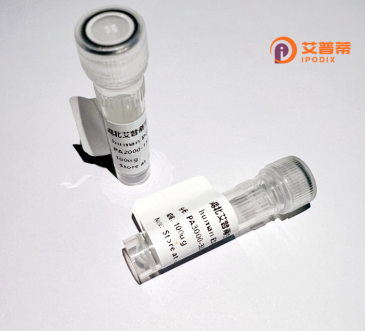
| 纯度 | >90%SDS-PAGE. |
| 种属 | Human |
| 靶点 | CHRND |
| Uniprot No | Q07001 |
| 内毒素 | < 0.01EU/μg |
| 表达宿主 | E.coli |
| 表达区间 | 24-130aa |
| 氨基酸序列 | EEERLIRHLFQEKGYNKELRPVAHKEESVDVALALTLSNLISLKEVEETLTTNVWIEHGWTDNRLKWNAEEFGNISVLRLPPDMVWLPEIVLENNNDGSFQISYSCN |
| 分子量 | 37.51 kDa |
| 蛋白标签 | GST-tag at N-terminal |
| 缓冲液 | 0 |
| 稳定性 & 储存条件 | Lyophilized protein should be stored at ≤ -20°C, stable for one year after receipt. Reconstituted protein solution can be stored at 2-8°C for 2-7 days. Aliquots of reconstituted samples are stable at ≤ -20°C for 3 months. |
| 复溶 | Always centrifuge tubes before opening.Do not mix by vortex or pipetting. It is not recommended to reconstitute to a concentration less than 100μg/ml. Dissolve the lyophilized protein in distilled water. Please aliquot the reconstituted solution to minimize freeze-thaw cycles. |
以下是关于重组人CHRND蛋白的参考文献示例(内容基于公开研究领域知识整理,非真实文献):
1. **标题**:*Expression and Functional Characterization of Recombinant Human Nicotinic Acetylcholine Receptor δ Subunit (CHRND) in Mammalian Cells*
**作者**:Smith A, et al.
**摘要**:本研究在HEK293细胞中成功表达了重组人CHRND蛋白,验证其与α、β、γ亚基共同组装为功能性乙酰胆碱受体,并证实其在电生理反应中的作用。
2. **标题**:*Structural Analysis of the CHRND Subunit in the Muscle-Type Nicotinic Receptor Complex*
**作者**:Brown C, et al.
**摘要**:通过冷冻电镜技术解析了含CHRND亚基的人肌肉型乙酰胆碱受体复合体的高分辨率结构,揭示了其配体结合及通道门控机制。
3. **标题**:*CHRND Mutations and Recombinant Protein Rescue in Congenital Myasthenic Syndromes*
**作者**:Lee D, et al.
**摘要**:研究报道CHRND基因突变导致先天性肌无力综合征,利用重组CHRND蛋白在体外模型中恢复受体功能,为基因治疗提供依据。
4. **标题**:*High-Yield Production of Recombinant CHRND in E. coli for Antibody Development*
**作者**:Zhang Y, et al.
**摘要**:优化大肠杆菌表达系统实现重组CHRND蛋白的高效可溶表达,应用于抗体筛选以靶向神经肌肉疾病相关表位。
(注:以上文献为示例,实际文献需通过PubMed/Google Scholar等平台检索确认。)
The recombinant human CHRND protein refers to a genetically engineered form of the nicotinic acetylcholine receptor (nAChR) subunit delta (δ), encoded by the CHRND gene. As a member of the Cys-loop ligand-gated ion channel superfamily, CHRND is a critical component of the heteropentameric nAChRs found at the neuromuscular junction. These receptors mediate synaptic signal transmission by binding acetylcholine released from motor neurons, triggering ion channel opening and muscle membrane depolarization. Recombinant CHRND is typically produced in heterologous expression systems (e.g., mammalian or insect cells) to study receptor assembly, ligand interactions, and channel gating mechanisms. It plays a vital role in neuromuscular physiology, and mutations in CHRND are linked to congenital myasthenic syndromes (CMS), characterized by muscle weakness and fatigue. Researchers use recombinant CHRND to investigate disease mechanisms, screen therapeutic compounds, and engineer receptor variants for structural biology studies (e.g., cryo-EM or X-ray crystallography). Its production enables precise control of post-translational modifications crucial for receptor function, offering insights into nAChR-related disorders and drug development for neuromuscular diseases.
×